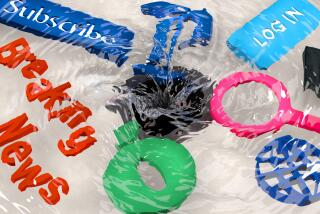S.F. Papers Slowly Return to Normal : Strike: Production facilities are restarted. Union spokesman urges employees to ‘let go of the anger.’
- Share via
SAN FRANCISCO — The 12-day strike at the city’s two daily newspapers is over but operations were so crippled that the San Francisco Chronicle and the San Francisco Examiner are only slowly recovering.
The Chronicle, printing a Tuesday edition so thin that it was barely enough to swat a fly, apologized to readers, saying that production facilities were damaged and delivery systems were disrupted by the strike.
“It’s hard to start the thing back up,” said Jim Hale, president of the San Francisco Newspaper Agency, which prints and delivers both papers under a joint operating agreement.
Hale said one of the agency’s three printing plants was put out of commission when striking workers contaminated tanks of ink with human urine. By Tuesday, he said, the tanks had been drained and the contamination had been cleaned up.
The newspaper agency was gradually calling back its printers, advertising staff and other workers and planned to resume full operations within a week. As a result, both papers were able to print only the slimmed-down editions.
The Examiner, printing one daily edition instead of its usual four, was gradually bringing its 215 workers back. By the end of the day had called in fewer than half. The Chronicle, however, called back all its employees Monday in hopes of bringing about reconciliation more quickly.
“We have been through a painful period,” Chronicle Managing Editor Dan Rosenheim said. “Events like this strike create wounds, but I am very hopeful we will quickly get beyond that.”
During the strike, there were scattered reports of violence and Kent Wilson, a striking driver, was electrocuted while allegedly tampering with a power line at a distribution center for the papers.
Members of the eight newspaper unions believe they were the victors in the walkout, winning a 3% raise over three years and preventing proposed staff cutbacks.
Planning their strike strategy months in advance, the unions succeeded in disrupting the paper’s normal operations by getting longshoremen not to unload newsprint at the docks, persuading businesses not to advertise and convincing some carriers not to deliver papers.
When the strike ended Monday, management and workers alike were hoping to rebuild the papers quickly, expanding the 32-page editions both papers printed Tuesday to 64 pages or more by next week.
“I’m telling everyone to try to let go of the anger,” said Carl Hall, a reporter and spokesman for the Newspaper Guild, the union representing editorial employees. “We want everything to get fixed, the plants as well as the relationships, as fast as possible.”
Nevertheless, he said, the strikers will not quickly forget who supported them and who did not. Inside the Chronicle building, he noted, there is a coffee shop and a barber shop. The barber honored the picket lines; the owner of the coffee shop went to work and served food to strikebreakers.
“I don’t think he’s going to have a very easy time selling coffee,” Hall said. “But I think Joe the barber is going to have patrons lined up outside his door.”
Herb Caen, the legendary 78-year-old Chronicle columnist who walked the picket line with his fellow strikers, reappeared in the paper Tuesday. He noted that the only other times he had missed a deadline were during World War II and during a 52-day newspaper strike in 1968.
“We are back where we belong: on your doorstep, playing our small but hopefully important role in your busy lives,” he wrote. “. . . Especially in a smallish city like this one, people need and want a newspaper and ‘feel lost without it.’ ”
Indeed, readers around the Bay Area welcomed back their newspapers--even the abbreviated editions that were delivered.
“I’m delighted to have the strike over and the paper back to almost normal thickness,” said recycling company executive Jerry Lucey. “As a San Franciscan, I think it’s important to read the San Francisco Chronicle--good or bad.”
Times researcher Norma Kaufman contributed to this report.
More to Read
Sign up for Essential California
The most important California stories and recommendations in your inbox every morning.
You may occasionally receive promotional content from the Los Angeles Times.













